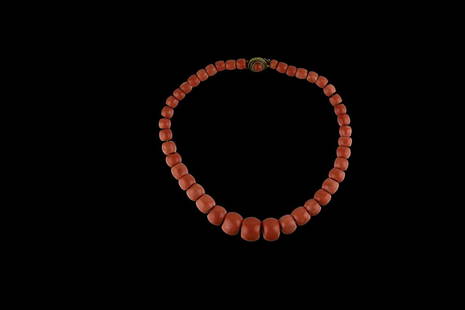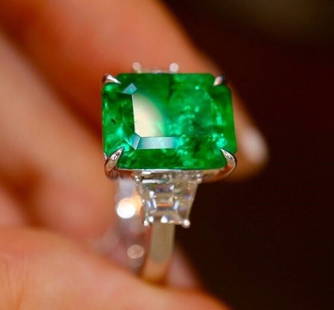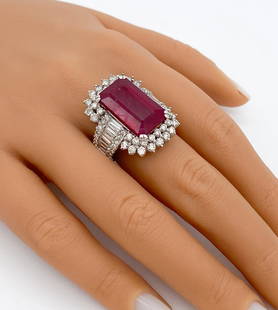
18th C. Tokugawa Japanese Bronze Champlevé Bodhisattva
Similar Sale History
View More Items in Necklaces & PendantsRelated Necklaces & Pendants
More Items in Japanese Necklaces & Pendants
View MoreRecommended Jewelry
View More


Item Details
Description
East Asia, Japan, Tokugawa Shogunate, ca. 18th century CE. A champlevé, bronze, shakudo bodhisattva figure, cast in the round, seated on an elephant-lion animal figure. The entity appears to be a combination of Manjusri (the Bodhisattva of Wisdom who traditionally rides a lion) and the Samantabhadra (Bodhisattva of Benevolence/Universal Virtue who traditionally rides an elephant) holding a lotus in the left hand and a scroll in the right as Samantabhadra is patron of the Lotus Sutra, and according to Avatamsaka Sutra, made ten vows that became the foundation of a bodhisattva. The piece is comprised of two cast bronze figures, bodhisattva and mythical animal, with champlevé enamel work on the clothing and fabrics, the halo and figures also formed in shakudo. The triple hollyhock (known in Japanese as a mon) crest featured on the robe and saddle blanket is readily recognized as a symbol of the Tokugawa clan, the last shogunate that reigned from 1603 to 1867. Size: 12.25" L x 15.375" H (31.1 cm x 39.1 cm)
The Bodhisattva wears an elaborate headdress and upswept coiffure with high top knot, necklace, bracelets, armbands, a silk robe that billows over his form, with the right leg bent, and a cast halo of a flat form with spoke-like protrusions. The halo section as well as the figures also appear to be formed in shakudo (a billon of gold and copper - typically 4-10% gold, 90-96% copper) providing that red coppery finish, making this piece very rare, according to appraiser Tomoo Ogita, and "most likely made for the Tokugawa family since there are crests of the 'triple hollyhock leaves' on the object." On the saddle blanket is decoration in multicolor enamels on a blue ground of the Chinese lion and peonies. The Bodhisattva's robe is also decorated with dominant blue hues. Areas of the animal's head and tail are impressively modelled. The Manjusri is called Monju in Japanese and Wen-shu in Chinese; the Samantabhadra is called Fugen in Japanese and P'u-hsien in Chinese.
Champlevé is an enamel technique in which cells or troughs are carved, etched, cast, or die struck into the surface of a metal work, and then filled with vitreous enamel. Next, the piece is fired until the enamel fuses. After it cools, the surface is polished. Uncarved portions of the original surface remain visible as a frame for the enamel designs and are sometimes gilded. The name Champlevé comes from the French word for "raised field", "field" meaning background, this said the technique actually lowers the area to be enameled rather than raising the rest of the surface. Champlevé differs from the cloisonné enamel technique in which troughs are created by soldering flat metal strips to the surface of the object.
An incredible piece, replete with impressive artistry, a wide range of techniques, and layers of symbolic meaning that according to Tomoo Ogita was most likely created for the Tokugawa family in the 18th century.
This piece was examined by Tomoo Ogita in 1975 and appraised for $4,200 at that time. Ogita is the co-author of "Asian Cloisonné Enamels" by T. Ogita & Richard B. Peterson. Los Angeles: Dorothy Adler Routledge Publishers, 1975. A copy of the certificate of appraisal signed by Tomoo Ogita will accompany this piece.
Provenance: Ex- O'Keefe collection, New Jersey
All items legal to buy/sell under U.S. Statute covering cultural patrimony Code 2600, CHAPTER 14, and are guaranteed to be as described or your money back.
A Certificate of Authenticity will accompany all winning bids.
We ship worldwide to most countries and handle all shipping in-house for your convenience.
#121037
The Bodhisattva wears an elaborate headdress and upswept coiffure with high top knot, necklace, bracelets, armbands, a silk robe that billows over his form, with the right leg bent, and a cast halo of a flat form with spoke-like protrusions. The halo section as well as the figures also appear to be formed in shakudo (a billon of gold and copper - typically 4-10% gold, 90-96% copper) providing that red coppery finish, making this piece very rare, according to appraiser Tomoo Ogita, and "most likely made for the Tokugawa family since there are crests of the 'triple hollyhock leaves' on the object." On the saddle blanket is decoration in multicolor enamels on a blue ground of the Chinese lion and peonies. The Bodhisattva's robe is also decorated with dominant blue hues. Areas of the animal's head and tail are impressively modelled. The Manjusri is called Monju in Japanese and Wen-shu in Chinese; the Samantabhadra is called Fugen in Japanese and P'u-hsien in Chinese.
Champlevé is an enamel technique in which cells or troughs are carved, etched, cast, or die struck into the surface of a metal work, and then filled with vitreous enamel. Next, the piece is fired until the enamel fuses. After it cools, the surface is polished. Uncarved portions of the original surface remain visible as a frame for the enamel designs and are sometimes gilded. The name Champlevé comes from the French word for "raised field", "field" meaning background, this said the technique actually lowers the area to be enameled rather than raising the rest of the surface. Champlevé differs from the cloisonné enamel technique in which troughs are created by soldering flat metal strips to the surface of the object.
An incredible piece, replete with impressive artistry, a wide range of techniques, and layers of symbolic meaning that according to Tomoo Ogita was most likely created for the Tokugawa family in the 18th century.
This piece was examined by Tomoo Ogita in 1975 and appraised for $4,200 at that time. Ogita is the co-author of "Asian Cloisonné Enamels" by T. Ogita & Richard B. Peterson. Los Angeles: Dorothy Adler Routledge Publishers, 1975. A copy of the certificate of appraisal signed by Tomoo Ogita will accompany this piece.
Provenance: Ex- O'Keefe collection, New Jersey
All items legal to buy/sell under U.S. Statute covering cultural patrimony Code 2600, CHAPTER 14, and are guaranteed to be as described or your money back.
A Certificate of Authenticity will accompany all winning bids.
We ship worldwide to most countries and handle all shipping in-house for your convenience.
#121037
Condition
Some expected surface wear, pitting to enamel, and minor abraded areas. Overall good condition.
Buyer's Premium
- 24.5%
18th C. Tokugawa Japanese Bronze Champlevé Bodhisattva
Estimate $6,000 - $9,000
16 bidders are watching this item.
Shipping & Pickup Options
Item located in Louisville, CO, usSee Policy for Shipping
Payment
Accepts seamless payments through LiveAuctioneers

TOP





















































































